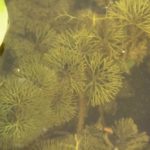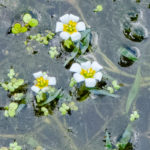Cabomba caroliniana
USDA, NRCS. 2018. The PLANTS Database (http://plants.usda.gov, 28 March 2018). National Plant Data Team, Greensboro, NC 27401-4901 USA.
Illustration courtesy of University of Florida/IFAS Center for Aquatic and Invasive Plants. Used with permission.
What is Carolina Fanwort?
Physical Characteristics
Leaves:
- Opposite or whorled
- Leaf stalk up to 1 3/16 inches long
- Round shape
- Divided into linear thread-like parts
Floating:
- Few floating leaves
- Alternate
- Shield-shaped
- Slightly thinner in the middle
- Often divided by deep notch at one end
- About 0.7874 inches long
Flowers:
- Single flower at end of long
- Slender peduncles
- 1/2 inch long
- White or cream in color
- Yellow spots at base
- Sometimes tinted pink at tips
- 3 sepals
- 3 oval-shaped petals
- 6 stamen
- Short anthers
Fruit:
- 3 seeds
- Does not split open to release the seeds when ripe
Stems:
- Slender
- Branching
- 6 1/2+ feet long
- Have a thin, jelly coating
Roots:
- Rooted in mud
Where Does it Grow?
EDDMapS. 2024. Early Detection & Distribution Mapping System. The University of Georgia – Center for Invasive Species and Ecosystem Health. Available online at http://www.eddmaps.org/; last accessed January 17, 2024.
Carolina fanwort can be found in lakes, ponds, and quiet streams.
Pros and Cons of Carolina Fanwort
Fanwort has little known direct food value to wildlife. Submerged portions of all aquatic plants provide habitats for many micro and macro invertebrates. These invertebrates in turn are used as food by fish and other wildlife species (e.g. amphibians, reptiles, ducks, etc.). After aquatic plants die, their decomposition by bacteria and fungi provides food (called “detritus”) for many aquatic invertebrates.






